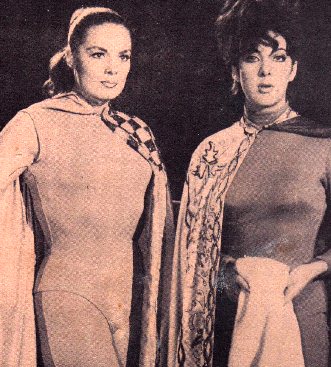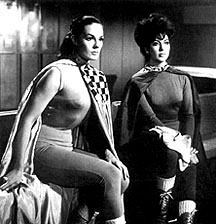Las luchadoras contra la momia*
[The Wrestling Women vs. the Mummy]
(Cin.
Calderón, 1964) Prod: Guillermo Calderón Stell; Dir:
René Cardona [Sr.]; Adapt: Alfredo Salazar; Story: Alfredo Salazar,
Guillermo Calderón Stell; Photo: Ezequiel Carrasco; Music: Antonio
Díaz Conde; Prod Mgr: Luis García de León; Prod
Chief: José Luis Busto; Asst Dir: Jesús Marín; Film
Ed: Jorge Bustos; Art Dir: José Rodríguez Granada; Decor:
Adalberto López; Lighting: Luis García; Makeup: Felisa
Ladrón de Guevara; Sound Supv: James L. Fields; Sound: Eduardo
Arjona, Galdino Samperio; Sound Ed: José Li-Ho; Union: STPC
*[English-language version: Wrestling Women vs. the Aztec Mummy--
Prod: K. Gordon Murray; Dir: Manuel San Fernando; character names which
differ in English-language version are shown in brackets after original
character name]
*[a subsequent video release is entitled Rock 'n
Roll Wrestling Women vs. the Aztec Mummy]
CAST: Lorena Velázquez (Loreta Venus), Elizabeth Campbell
(Golden Rubí), Armando Silvestre (Armando Ríos [Mike
Henderson]), Chucho Salinas (Chucho Gómez [Tommy]), María
Eugenia San Martín (Chela [Charlotte Van Dine]), Ramón
Bugarini (Prince Fujiyata), Jesús "Murciélago"
Velázquez (Mao), Víctor Velázquez (Dr. Luis Trelles
[Dr. Tracy]), Julián de Meriche (Dr. Miguel [Mike] Sorva), Gerardo
Zepeda (Temozoc), Armando Acosta (detective), Manuel Dondé (hotel
clerk), Mario Sevilla (hat store clerk), Ballet de Milagros Oliva,
Toña la Tapatía, Irma González, Chabela Romero,
Martha Solis, Magdalena Caballero, Juan Garza, Mishima Ota, Uroki Sito, N.
León "Frankestein," Reyes Oliva, Gerardo "El Romano"
 NOTES: The availability of this film in an English-dubbed version has
made it somewhat more notorious than it might actually deserve. The
second "Luchadoras" feature, Las luchadoras contra la momia is
rather disjointed and not at all as campy as its predecessor.
NOTES: The availability of this film in an English-dubbed version has
made it somewhat more notorious than it might actually deserve. The
second "Luchadoras" feature, Las luchadoras contra la momia is
rather disjointed and not at all as campy as its predecessor.
As I have noted before, one major problem with the "luchadoras" films
is that the stars don't do their own stunts (for the most part--both
leading actresses did some light combat), requiring the use of
obvious doubles and actually limiting the amount of physical action in
each film. Masked wrestlers like El Santo didn't do much acting
(their dialogue being post-dubbed), but they did their own fighting (and
with the masks, it's harder to tell, anyway). Speaking of dubbing, the
voices assigned to Lorena Velázquez and Elizabeth Campbell at
"Soundlab" in Coral Gables, Florida, are unpleasant and annoying, and
Jesús Velázquez's character ("Mao") is called "Mayo"
throughout the picture.
A couple of other flaws worth noting: Lorena
Velázquez's hairstyle changes from shot to shot in some scenes, a
bat flies backwards out of window, and a substantial amount of
footage is allegedly shot via a hidden camera (which is itself shown
numerous times, to remind the audience of the point-of-view being
presented, I guess) that is apparently capable of tracking, panning,
zooming, and even looking in other rooms, all from its location on a shelf
(next to a bottle of liquor!).
But the biggest problem with Las luchadoras contra la momia is
the overall lack of mummy. At least 75% of the film concerns the efforts
of sinister Prince Fujiyata to obtain fragments of a codex in order to
locate a hidden Aztec treasure. Only very late does the mummy arise and
start stalking around. Temozoc, as he's called this time, is pretty
impressive looking: glaring eyes, a skull-like grimace, and sparse hair
(as opposed to Popoca's long tresses in the Aztec Mummy trilogy).
Although Gerardo Zepeda plays Tezomoc in his pre-mummified existence, it's
not known if the burly actor was also inside the mummy costume.

A few trivia notes: Lorena Velázquez appears not only with her
father, Víctor Velázquez, but her uncle Manuel Dondé
(whose sister married Víctor Velázquez) also has a small
role. Elizabeth Campbell is as taller or taller than anybody else in the
cast (Lorena's poofy hairdo makes up the difference at times), and she
bears a surprising resemblance to a young Ann-Margret in certain scenes
(when she's wearing a sweater and tight black capri pants).
The plot:
several archeologists have been murdered by the Black Dragon gang of
Prince Fujiyata. He is trying to obtain all the fragments of a codex
which shows the location of an Aztec treasure. Dr. Sorva eludes the gang
and hides in the dressing room of Loreta and Rubí, famous wrestling
women. Loreta's boyfriend is Armando, whose uncle is Dr. Trelles, the
final member of the archeological expedition. After Sorva tells his
story, he's killed by a poisoned dart. Chela Van Dine, the daughter of
one of the murdered scientists, has gone to Dr. Trelles for help.
In
order to confound the Black Dragons, Trelles tells Rubí, Loreta,
Armando and Armando's assistant Chucho, that he has split his part of the
codex into three fragments. He disappears to try and throw Fujiyata off
the track, but later tips off his friends to the hiding places of the
codex parts. However, the Black Dragons kidnap Chela and turn her into a
zombie; she helps them steal two of the codex scraps. The third part is
hidden in the Luchadoras' locker room: Fujiyata and his men face off with
Armando, Loreta, Rubí, and Chucho. The Asian mastermind proposes a
sporting bet: his two sisters (judo experts) will face the Luchadoras in a
winner-take-all match. The combat is difficult, but the Luchadoras beat
their stocky opponents (both of the "Asian" women look more or less like
rotund comedienne Susana Cabrera, hardly a fearsome sight), and Fujiyata
turns over his part of the codex. [Alfredo Salazar re-used this plot
device in Santo en el tesoro de Drácula, and it was even
less logical the second time around] Armando tries to arrest Fujiyata and
his gang for murder, but Fujiyata's sisters beat up Armando and Chucho and
the gang escapes!
Dr. Trelles deciphers the codex and they all go to a
hidden chamber in an Aztec pyramid. According to Trelles, during the
Aztec era a young maiden named Xóchitl (aren't they all?) was
scheduled to
be sacrified to the gods but instead ran off with Temozoc, a sorcerer.
Both were caught: Xóchitl (although presumably not a virgin any
longer)
was sacrificed nonetheless and Temozoc was buried alive to serve as her
guardian. A breastplace inscribed with directions to the treasure horde
was placed on Xóchitl's body.
Trelles and the others remove the
breastplate from Xochitl's dessicated corpse (which has a couple of rats
still chewing on it, although I doubt if there was much meat left on her
after a couple of hundred years). Temozoc wakes up but since he's as slow
and clumsy as all movie mummies, the intruders escape.
Fujiyata and
his gang plan to steal the breastplate and then take possession of the
treasure, but Temozoc wipes them out. He also tries to get the
breastplate back but has to return to his tomb by daybreak (his sorcerer's
powers allow him to turn into a bat and fly around, the source of the
backwards-exit alluded to earlier; the producers were too damn cheap to
shoot 10 seconds of additional film, so they just reversed the bat's
arrival!).
Chucho and Chela decide to return the breastplate to
the tomb themselves, but get separated inside the pyramid. Chucho brings
Armando, Rubí and Loreta back to help. Temozoc turns into a bat
and a tarantula, but is eventually captured by having a bag put over his
head (his eyes are his source of power). He's also scared of fire. The
breastplate is returned. Temozoc still wants to do some strangling, but
the tomb collapses, burying him (Armando, Loreta, Chucho, Rubí,
etc., escape).
Las luchadoras contra la momia has a cult
reputation and a lot of people like it for its "camp" aspects, but it
really sounds wackier than it is. The Aztec Mummy trio is more
consistently entertaining, and the Luchadoras are better served in their
first feature and Las luchadoras vs. el robot asesino is good but doesn't
feature either Lorena Velázquez or Elizabeth Campbell). To recap,
good mummy but not enough of him.
Posted 3 June 99, edited 8 Dec 2006 by
dwilt@NOSPAMumd.edu (remove NOSPAM if you want to e-mail me)
 NOTES: The availability of this film in an English-dubbed version has
made it somewhat more notorious than it might actually deserve. The
second "Luchadoras" feature, Las luchadoras contra la momia is
rather disjointed and not at all as campy as its predecessor.
NOTES: The availability of this film in an English-dubbed version has
made it somewhat more notorious than it might actually deserve. The
second "Luchadoras" feature, Las luchadoras contra la momia is
rather disjointed and not at all as campy as its predecessor.
